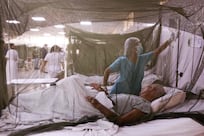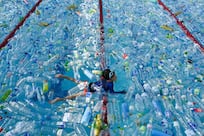RAS AL KHAIMAH // Hamad Ismail has achieved something man has always dreamt of.
Side by side with three friends, Hamad has restored the old pearling village of his childhood, and in doing so has wrested back his youth from the ravages of age.
"When I come to this place, walking before the houses, I feel something else that no one else can feel," he says. "Seven years I'm walking from this mosque to my house. I can feel the people who lived here before, who walked in this street, who prayed in this mosque."
Hamad, 35, lived in Jazirat Al Hamra, a village of coral and sand bricks, before he and the entire community were relocated to more modern housing in the mid-1980s.
Like many, the photographer felt a strong connection to the old place on the coast, and dismay as it fell victim to gradual decay and mindless disrespect, with tourists tearing doors from homes for souvenirs and youths vandalising the alleyways with graffiti.
The RAK Government was unable to preserve the buildings, some of which were 100 years old and built in a pre-oil Gulf style.
The dozens of families who owned the buildings feared what would happen to their old community if they sold up, wary of encroaching developments such as the snow-themed aquapark, Ice Land.
But Hamad lives by a simple credo, one that would not allow him to see his village vanish into the dust: "You know if you see your house is not clean, your life will be difficult. This area is our home."
In December he and Abdulla Meyahi, Mohammed Hilal and Ismail Rashed started to clean the area around the old mosque and surrounding market.
Each day Hamad would finish his duties at Etisalat and then work in the village until sundown.
Renovations led to discoveries, such as the way their grandfathers faced the sun, and the thorn-covered mound where the women would wait for their husbands at the end of the pearling season.
It was not long before elderly visitors, nearby residents and even tourists began to offer support.
"When they started cleaning [the village], the old man Salem asked what they were doing and he started to donate," says Khamis Al Zaabi, a friend of the men.
"When other people saw this they started to donate … after this, word spread around and the Sheikh of Ras Al Khaimah himself donated money. I won't mention how much."
The men laboured side by side with municipal workers.
Now the graffiti is covered, the old passageways are cleared and visitors can wander the streets and imagine life in the days of the pearl.
"You can see into the past and see how it was. You can see the difference between how it is and how it was," says Yousef bin Shaker, 25, an Emirati photographer who came with his friends.
"You can feel it. Before you could not feel it."
Men who left the village decades ago now return to the old mosque each evening with their sons. They gather on a wooden platform to catch the sea breeze and share political discussion of the present and stories of the past.
The village is said to be home to many jinn, the supernatural beings known to inhabit abandoned houses. But Hamad thinks not.
"We haven't seen anything for this," he says. "You feel it's jinn because you are afraid. It's a fox. It's nothing."
But as he speaks, the elder Saleh bin Jumeah sits on the other side of the majlis, telling stories of the local ghost ship.
The renovation brings the greatest joy to former residents, who will celebrate the rebirth of their village with a party at the end of this month, the first since 1982.
"This house with the green door is mine," says Hassan Ali, bumping over roads that were once impassable. When he speaks, everything is from "the pearl age" or "the time of the divers".
"In the pearl age, the main place for the pearls was Jazirat," Hassan says. "We all started from the pearl."
It is clear his precious youth has also been returned to him.
"That's the Friday mosque by the sea and this is the girls' school. Wallah, it's old," Hassan says. "And that's my old school there. I didn't go much, I would always run away.
"This is ya salam [fantastic]. I want people from the whole world to see this. This is the life of my childhood."






